Mardi Gras Decoration
What Does a Wreath on the Front Door Mean?

As authors, we frequently feel a magnetic pull towards the symbolism encapsulated in mundane items. The presence of a wreath decorating an entrance door carries a subtle importance that crosses cultural and traditional boundaries. It stands as an enduring symbol of hospitality, festivity, and memory.
The history and symbolism of wreaths have evolved over centuries, reflecting the values and beliefs of diverse societies. From ancient Greece to modern-day households, the wreath on the front door remains a subtle yet meaningful expression.
In this collection, we will explore the various meanings behind this simple yet powerful adornment, delving into its historical origins, cultural significance, and contemporary interpretations.
Key Takeaways
- Wreaths on the front door symbolize hospitality and goodwill.
- Hanging a wreath on the front door offers protection and blessings to all who enter.
- Evergreen in wreaths symbolizes perpetuity and resilience.
- Berries represent nourishment and abundance.
Historical Origins of Wreaths
Wreaths have been used throughout history to symbolize various cultural, religious, and seasonal significances, with evidence of their existence dating back to ancient civilizations. In ancient traditions, wreaths were crafted from evergreen branches, symbolizing eternal life and renewal. These early wreaths were often worn as headdresses or displayed in homes as a form of protection and a celebration of the changing seasons. Their circular shape represents the cycles of nature and the continuity of life.
Religious significance has also played a significant role in the history of wreaths. In many cultures, they were used in ceremonies and rituals, symbolizing the divine and spiritual nature of life and the interconnectedness of all living beings. In Christianity, the Advent wreath, with its evergreen branches and four candles, represents hope and the eternal light of Christ. Each candle lit during the weeks leading up to Christmas represents different virtues and aspects of spiritual preparation.
The historical origins of wreaths reveal a deep connection to nature, spirituality, and the human experience, reflecting the enduring significance of these timeless symbols.
Symbolism Across Different Cultures
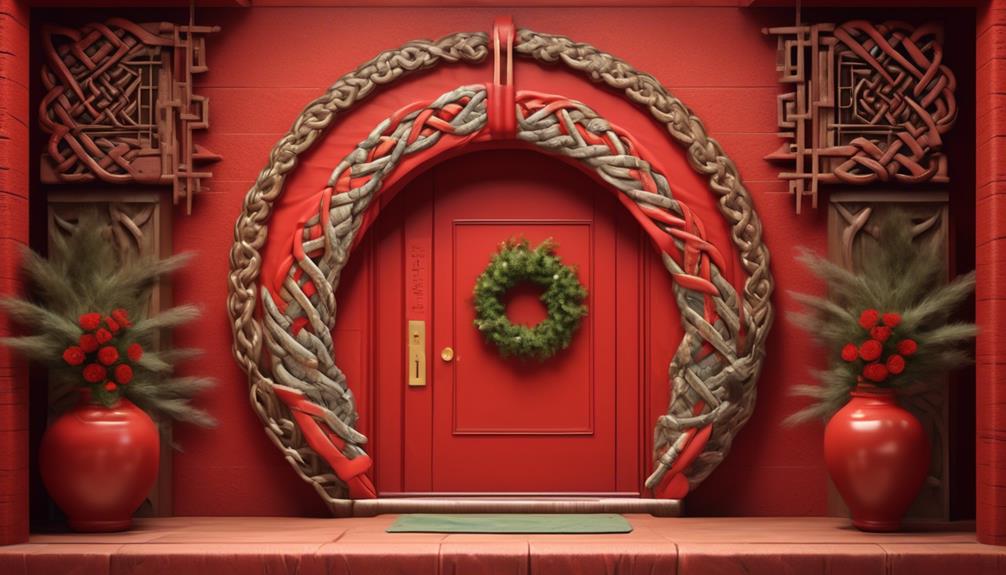
Symbolizing diverse cultural and spiritual beliefs, wreaths have held significant botanical and symbolic meaning across various civilizations throughout history. The cultural significance and religious traditions associated with wreaths vary widely, each carrying its own unique symbolism and significance. Here is a glimpse into the rich cultural tapestry of wreath symbolism across different civilizations:
| Culture | Symbolism |
|---|---|
| Ancient Greece | Victory, honor, and eternal life |
| Celtic Tradition | Connection to nature and the changing seasons |
| Hinduism | Cycle of birth, death, and rebirth |
| Christianity | Everlasting life and the circle of eternity |
These examples merely scratch the surface of the profound cultural and religious meanings attributed to wreaths. The intricate intertwining of botanical elements represents the interconnectedness of humanity with nature, while the circular shape symbolizes eternity and the cyclical nature of life. Whether adorning doors or used in ceremonial rituals, wreaths continue to serve as powerful symbols of cultural tradition and spirituality, weaving a timeless thread that unites us across diverse beliefs and practices.
Wreaths for Seasonal Celebrations
As we explore the significance of wreaths for seasonal celebrations, we witness the seamless intertwining of nature's beauty and cultural traditions across various civilizations. Seasonal wreath traditions have been cherished for centuries, symbolizing the cyclical nature of life and the ever-changing seasons. Festive wreath decor not only adorns our homes but also serves as a reflection of our deep-rooted connection to nature and the rhythms of the earth.
- Evergreen Elegance: The use of evergreen foliage in seasonal wreaths signifies resilience, hope, and the promise of renewal, especially during winter festivities.
- Floral Abundance: Incorporating vibrant flowers into wreaths for seasonal celebrations represents the joy and vibrancy of spring and summer, celebrating the abundance of nature's beauty.
- Harvest Homage: Fall wreaths adorned with elements like berries, wheat, and dried leaves pay homage to the bountiful harvest, symbolizing gratitude and abundance.
The crafting and display of seasonal wreaths aren't merely decorative; they're an expression of our reverence for the natural world and a celebration of the unique characteristics of each season. These wreaths infuse our homes with the spirit of the changing seasons, connecting us to the earth's rhythms and the timeless traditions of our ancestors.
Wreaths as Signs of Welcome

Adorning the front door with a wreath conveys a warm and inviting gesture, greeting visitors with the timeless symbolism of hospitality and goodwill. Wreaths have long been a cherished tradition, serving as a universal symbol of welcome. The act of hanging a wreath on the front door dates back to ancient times, where it was believed to offer protection and blessings to all who crossed the threshold. This tradition has evolved over the centuries, but its essence remains rooted in the spirit of hospitality.
| Tradition | Meaning |
|---|---|
| Evergreen | Perpetuity, resilience |
| Berries | Nourishment, abundance |
| Flowers | Beauty, friendship |
| Colors | Vibrancy, joy |
| Ribbon | Unity, connection |
The choice of materials and colors in a wreath holds significance. Evergreen symbolizes perpetuity and resilience, while berries represent nourishment and abundance. Incorporating flowers conveys beauty and friendship, while the colors and ribbons add vibrancy and unity. Each element intertwines to create a harmonious representation of hospitality and warmth.
In many cultures, the act of hanging a wreath is a customary gesture of extending hospitality. Its circular shape signifies eternity and the unending cycle of giving and receiving goodwill. As visitors approach, the wreath silently conveys a message of welcome, enveloping them in the timeless tradition of hospitality symbolized by the wreath on the front door.
Modern Interpretations and Trends
Entrancingly, wreaths have evolved with the passage of time, mirroring contemporary aesthetics and design sensibilities, while retaining their essence as enduring symbols of hospitality and warmth. In the modern era, wreaths have taken on new meanings and styles, reflecting the diverse influences of our time.
- Contemporary Designs: Today, wreaths come in a myriad of innovative designs, incorporating unconventional materials and asymmetrical arrangements that challenge traditional notions of symmetry and uniformity.
- Cultural Influences: From minimalist Scandinavian-inspired wreaths to vibrant and lush tropical designs, cultural influences are shaping the modern interpretation of wreaths, adding depth and meaning to these decorative symbols.
- Sustainable Practices: With a growing focus on sustainability, modern wreaths often feature eco-friendly elements such as dried flowers, foraged greenery, and recyclable materials, aligning with the ethos of environmental consciousness.
These contemporary trends reveal the adaptability and timelessness of wreaths, as they continue to symbolize warmth and welcome while embracing the spirit of innovation and cultural diversity.
Frequently Asked Questions
Can Wreaths Be Used for Purposes Other Than Decoration, Such as for Religious or Spiritual Rituals?
Absolutely, wreaths can hold deep significance for religious rituals and spiritual symbolism. In various traditions, they symbolize eternity, unity, and the cycle of life and death.
They're used to mark sacred spaces, such as altars or shrines, and are often incorporated into ceremonies and rituals to honor deities or commemorate important occasions.
The circular shape of the wreath represents the interconnectedness of all things, making it a powerful symbol in many spiritual practices.
Are There Any Specific Rules or Traditions Regarding the Placement of Wreaths on the Front Door, Such as Which Direction They Should Face or How They Should Be Hung?
When it comes to placement rules for wreaths on the front door, cultural significance and orientation play a vital role. Different traditions have specific hanging styles, directing attention to the symbolism behind the wreath.
In my experience, this has always been a captivating topic. It's intriguing how something as seemingly simple as a wreath can hold such deep meaning and tradition.
Do Different Types of Materials or Colors Used in Wreaths Hold Different Meanings or Symbolism?
Different materials in wreaths hold unique symbolism. For instance, evergreen symbolizes eternal life, while holly represents protection and goodwill.
Color representation in wreaths also carries cultural significance. Red signifies love and passion, while white represents purity and peace.
Understanding these symbolisms can add deeper meaning and connection to the wreath displayed on your front door.
Are There Any Superstitions or Beliefs Associated With Removing a Wreath From the Front Door?
Removing a wreath from the front door carries various superstitions and beliefs. Some cultures view it as disrupting the spiritual rituals that the wreath symbolizes, while others see it as removing protection or inviting bad luck.
The act may hold cultural significance, often tied to specific events or traditions. The symbolism behind wreath removal varies, reflecting the diverse beliefs and customs surrounding this botanical adornment.
How Have Wreath-Making Techniques and Materials Changed Over Time, and Are There Any Traditional Methods That Are Still Used Today?
Traditional techniques, like weaving and hand-tying, have endured over time, connecting us to the historical significance and cultural traditions of wreath-making.
Modern materials, such as artificial foliage and wire frames, have expanded the possibilities.
The evolution of wreath-making reflects our desire to preserve heritage while embracing innovation.
These shifts in techniques and materials have allowed us to create wreaths that honor the past while celebrating the present.
Conclusion
In the language of nature, a wreath on the front door speaks of the changing seasons, the cycle of life, and the warmth of hospitality.
It's a symbol of our connection to the earth, our traditions, and our shared humanity.
As we adorn our doors with these intricate circles of greenery, we're reminded of the timeless beauty and resilience of nature, and the enduring spirit of welcome that transcends all cultures and time.
- About the Author
- Latest Posts
Introducing Ron, the home decor aficionado at ByRetreat, whose passion for creating beautiful and inviting spaces is at the heart of his work. With his deep knowledge of home decor and his innate sense of style, Ron brings a wealth of expertise and a keen eye for detail to the ByRetreat team.
Ron’s love for home decor goes beyond aesthetics; he understands that our surroundings play a significant role in our overall well-being and productivity. With this in mind, Ron is dedicated to transforming remote workspaces into havens of comfort, functionality, and beauty.
Mardi Gras Decoration
How to Decorate Cubicle for Holiday?

When it comes to holiday decorating your work space, we all aspire to make a statement and spread some cheer. But where should we start? With a plethora of ideas and options available, it can be daunting.
However, fear not, because we're here to guide you through the process, offering practical tips and creative inspiration to transform your workspace into a festive wonderland.
So, how can you infuse the holiday spirit into your cubicle without going overboard or breaking the office decor rules?
Key Takeaways
- Incorporating a festive cubicle theme boosts morale and creates a vibrant work environment during the holiday season.
- Personalized touches like stockings or handmade ornaments add a unique and heartwarming feel.
- Creative lighting transforms a dull workspace into a cozy and cheerful environment.
- Embracing the festive spirit in office attire enhances the celebratory atmosphere and spreads holiday cheer throughout the office.
Festive Cubicle Themes
We have found that incorporating a festive cubicle theme can significantly boost morale and create a vibrant work environment during the holiday season.
Holiday cubicle decor can be a simple and effective way to spread joy and cheer throughout the office. Some festive cubicle ideas include adorning the space with twinkling lights, colorful garlands, and mini Christmas trees. These decorations not only brighten up the cubicle but also evoke a sense of holiday spirit. Additionally, personalized touches such as stockings or handmade ornaments can add a unique and heartwarming feel to the workspace.
Holiday cubicle decor doesn't have to be extravagant to make a big impact. Simple touches like themed desk accessories, festive wall art, and coordinating colors can transform a dull workspace into a merry retreat.
Embracing a festive cubicle theme not only benefits the individual but also contributes to a more joyful and cohesive office environment. By encouraging each other to participate in decorating our cubicles, we create a sense of community and togetherness, enhancing the overall holiday experience at work.
DIY Holiday Decorations
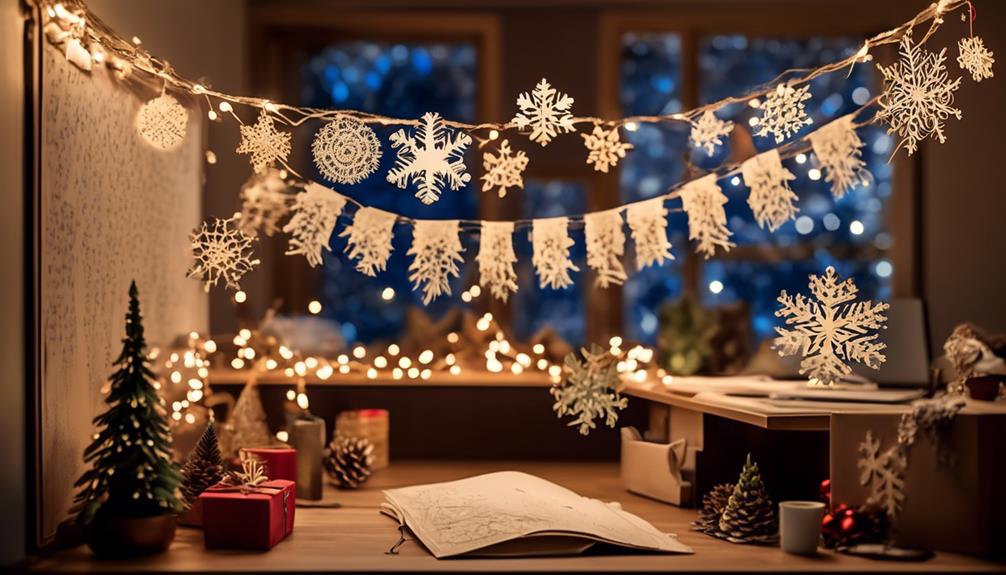
Let's get crafty and bring some holiday cheer to our cubicles with some delightful DIY decorations.
From festive desk accessories to seasonal wall art, there are endless ways to add a touch of holiday spirit to our workspace.
Get ready to roll up your sleeves and create a merry and bright atmosphere that will make our cubicle the talk of the office!
Festive Desk Accessories
Embellish your workspace with delightful DIY holiday decorations to infuse a festive spirit into your cubicle.
Get creative with festive office supplies by using colorful washi tape to add holiday patterns to your pens, pencils, and desk organizers.
For holiday desk organization, repurpose empty tin cans by wrapping them in festive paper to create cheerful pen and pencil holders.
Incorporate mini holiday-themed figurines or ornaments to add a touch of whimsy to your desk.
Utilize adhesive hooks to hang lightweight decorations like snowflakes or small wreaths.
Consider crafting personalized holiday-themed mouse pads or coasters using cork or felt for an added personalized touch.
These simple DIY decorations won't only brighten up your workspace but also spread holiday cheer to your colleagues.
Seasonal Wall Art
Transform your cubicle into a winter wonderland with charming DIY seasonal wall art, adding a festive touch to your workspace. Creating festive artwork for your office decor doesn't have to be complicated. Here are some simple and creative ideas to inspire you:
- Snowflake Garland: Cut out snowflakes from white paper and string them together to create a beautiful garland to hang on your cubicle walls.
- Holiday Banner: Craft a 'Happy Holidays' or 'Merry Christmas' banner using colorful cardstock and ribbon to brighten up your space.
- Seasonal Prints: Print out and frame festive artwork or quotes to bring some holiday cheer to your walls.
- DIY Wreath: Make a mini wreath using faux greenery, ornaments, and ribbon to add a touch of holiday spirit to your cubicle.
These easy DIY projects will help you infuse the spirit of the season into your workspace.
Cubicle Lighting Ideas
To create a festive ambiance in our cubicles, consider incorporating string lights or LED desk lamps to add a warm and inviting glow. Creative lighting can transform a dull workspace into a cozy and cheerful environment, perfect for the holiday season. Here are some cubicle lighting ideas to brighten up your workspace:
| Creative Lighting Ideas | Description |
|---|---|
| String Lights | Drape colorful string lights around your cubicle walls or hang them from the ceiling for a whimsical and festive look. Consider using battery-operated lights for convenience. |
| LED Desk Lamps | Choose LED desk lamps in holiday colors like red, green, or gold to provide both functional lighting and a touch of seasonal cheer to your workspace. Adjustable brightness settings can cater to different lighting needs, and some even come with color-changing options for added fun. |
| Fairy Lights | Decorate your cubicle with delicate fairy lights to create a magical and enchanting atmosphere. These tiny, twinkling lights can be wrapped around office supplies or draped over cubicle partitions for a whimsical effect. |
Personalized Desk Accessories

Let's infuse our workspaces with personality by incorporating personalized desk accessories that reflect our individual style and enhance our daily comfort and functionality. Personalized workspace decor can truly transform our work environment, making it a more inviting and inspiring place to spend our days.
Here are some customized office supplies that can add a personal touch to our desks:
- Customized Pen Holder: A stylish pen holder with our name or a meaningful quote can keep our writing tools organized and add a pop of personality to our desk.
- Personalized Mouse Pad: A customized mouse pad featuring a favorite photo or a motivational message can bring a smile to our face during long work hours.
- Monogrammed Desk Organizer: A monogrammed desk organizer not only keeps our stationery in order but also adds a touch of sophistication to our workspace.
- Engraved Nameplate: An engraved nameplate for our desk not only adds a professional touch but also makes us feel proud of our workspace.
These personalized desk accessories not only elevate the aesthetic appeal of our cubicles but also create a more personalized and enjoyable work environment for us and those around us.
Incorporating Holiday Colors

As we infuse our workspaces with personalized desk accessories that reflect our individual style, we can also add a festive touch by incorporating holiday colors into our cubicles. When it comes to holiday color schemes, we can consider traditional options like red, green, and gold, or opt for a modern twist with silver, blue, and white. These colors can be incorporated through small decorative items like desk organizers, calendars, or even festive throw pillows for our chairs. Integrating these holiday colors not only brings a cheerful ambiance to our cubicles but also spreads joy to our colleagues and clients who visit our workspace.
In addition to decorating our cubicles with holiday colors, we can also embrace the festive spirit by incorporating these hues into our office attire. Wearing clothing in traditional holiday colors or adding small accessories like a festive scarf or tie can further enhance the celebratory atmosphere. By incorporating holiday colors into both our workspace and attire, we can create a cohesive and joyful environment that spreads holiday cheer throughout the office.
Holiday Cubicle Contest Tips
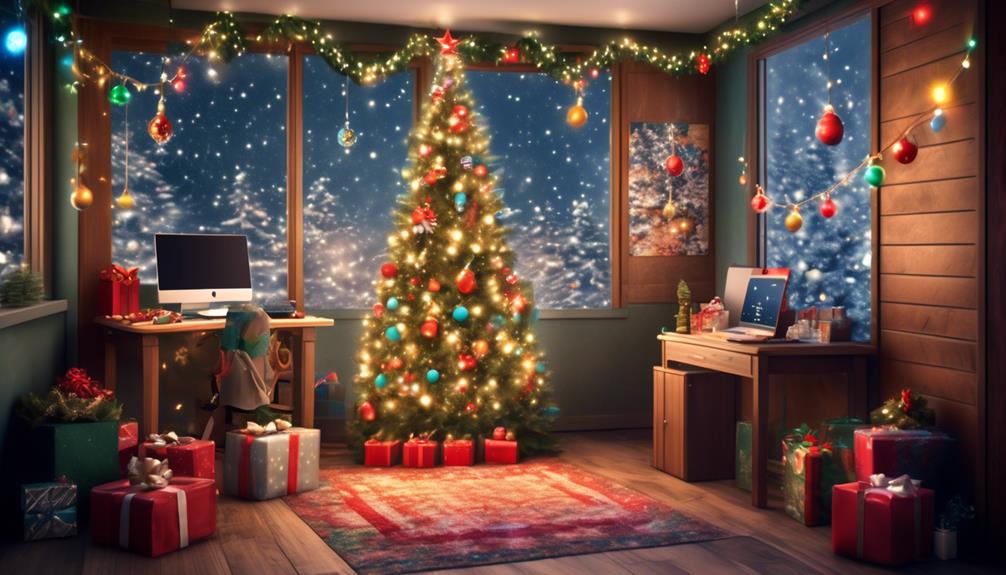
Embracing the festive spirit through creative and innovative cubicle decorations can greatly enhance our chances of winning the holiday cubicle contest. To stand out and impress the judges, consider the following holiday cubicle contest tips:
- Themed Decor: Choose a unique theme that reflects the holiday spirit, such as a winter wonderland, Santa's workshop, or a festive gingerbread house. Incorporating this theme into every aspect of your cubicle will make it memorable.
- Interactive Elements: Engage colleagues and judges by adding interactive elements to your cubicle, such as a holiday trivia game, a DIY ornament station, or a 'guess the number of candy canes' jar. These interactive features can make your cubicle the talk of the office.
- Innovative Use of Space: Utilize every inch of your cubicle creatively. Hang ornaments from the ceiling, create a holiday village on your desk, or use your filing cabinets as a canvas for a winter mural.
- Attention to Detail: Pay attention to the small details. Incorporate scents like cinnamon or pine, play festive music, and ensure that every aspect of your cubicle embodies the holiday cheer.
Frequently Asked Questions
How Can I Avoid Disrupting My Coworkers While Decorating My Cubicle for the Holidays?
We ensure our cubicle decor is respectful and festive, avoiding disruption to our coworkers. We use subtle decorations that don't obstruct traffic flow or create excessive noise.
We communicate with our team to ensure our festive additions don't interfere with their workspace or productivity.
Are There Any Specific Rules or Guidelines for Decorating My Cubicle in a Shared Office Space?
Cubicle decor can enhance our workspace, but it's crucial to adhere to office etiquette. When decorating, consider the impact on others and follow any specific guidelines set by our workplace.
Respectful and inclusive decor can foster a positive environment for all. Let's strive for creativity that doesn't disrupt our colleagues. As a team, we can create a festive atmosphere while maintaining professionalism and consideration for others.
What Are Some Budget-Friendly Options for Decorating My Cubicle for the Holidays?
Budget-friendly options for decorating our cubicle for the holidays include DIY decorations and festive lighting. We can repurpose everyday items like paper, ribbon, and old ornaments to create a festive atmosphere. Additionally, string lights and small LED decorations can add a touch of holiday cheer without breaking the bank.
These options allow us to get creative while staying within our budget and spreading holiday joy throughout the office.
How Can I Make Sure My Holiday Decorations Are Safe and Don't Pose a Fire Hazard in the Office?
When decking the halls at the office, we ensure holiday safety by being mindful of office fire hazards.
We keep decorations away from heat sources, use LED lights, and unplug them at the end of the day. It's like tending a cozy yule log, making sure it glows without sparking a fire.
Are There Any Tips for Storing My Holiday Decorations in My Cubicle When They're Not in Use?
When it comes to storing decorations, organizing supplies is key. We like to use labeled containers to keep everything in order.
It's important to find a designated space in the cubicle to store decorations when they're not in use. This helps maintain a tidy workspace and makes it easy to find everything when it's time to decorate for the holidays.
Plus, it ensures that our decorations stay safe and don't get damaged.
Conclusion
So, there you have it! Decorating your cubicle for the holidays doesn't have to be a daunting task. With a little creativity and some DIY magic, you can transform your workspace into a winter wonderland.
Just remember to stay within the company's guidelines and have fun with it! After all, 'tis the season to spread some holiday cheer, even in the office.
Happy decorating!
- About the Author
- Latest Posts
Introducing Ron, the home decor aficionado at ByRetreat, whose passion for creating beautiful and inviting spaces is at the heart of his work. With his deep knowledge of home decor and his innate sense of style, Ron brings a wealth of expertise and a keen eye for detail to the ByRetreat team.
Ron’s love for home decor goes beyond aesthetics; he understands that our surroundings play a significant role in our overall well-being and productivity. With this in mind, Ron is dedicated to transforming remote workspaces into havens of comfort, functionality, and beauty.
Mardi Gras Decoration
What Kind of People Celebrate Mardi Gras?
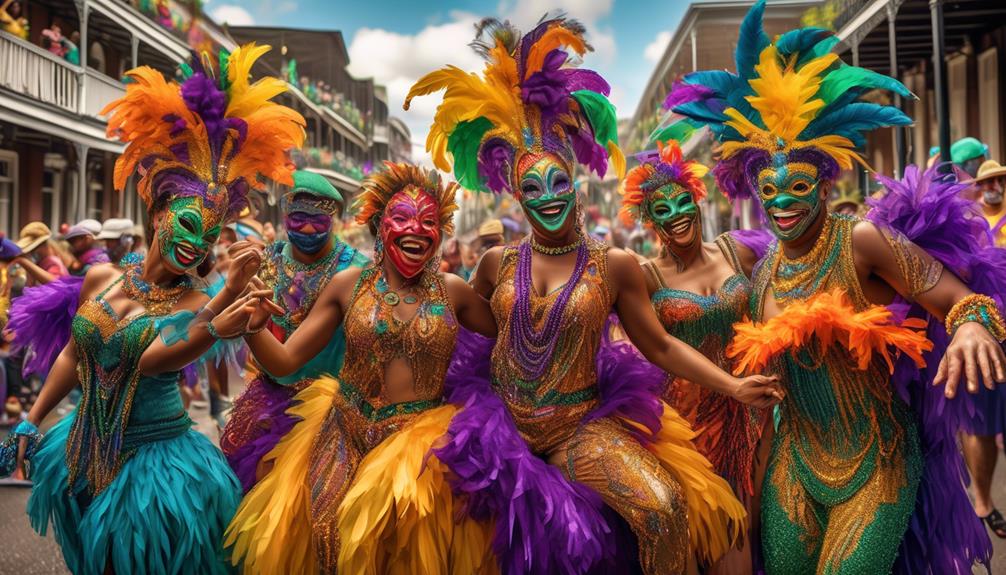
Mardi Gras is a colorful and lively gathering of people, blending tradition and celebration. It brings together locals who honor its origins with tourists looking for a memorable experience, creating a diverse and unique celebration.
But what exactly draws such a diverse crowd to this annual spectacle? The answer may surprise you.
Key Takeaways
- Mardi Gras attracts a diverse range of participants, including locals, tourists, families, and partygoers.
- Family-friendly activities and multigenerational traditions play a significant role in the celebration, strengthening family ties and preserving cultural practices.
- Cultural immersion is a palpable experience during Mardi Gras, with locals and visitors coming together to revel in traditions and the spirit of the festival.
- Enthusiasts of various interests, such as culture, food, music, and history, are drawn to Mardi Gras to immerse themselves in the vibrant costumes, culinary delights, musical heritage, and historical significance of the celebration.
Locals
As locals, we actively participate in the traditions and festivities of Mardi Gras, contributing to the vibrant energy and unique culture of our community. Mardi Gras is deeply rooted in our local traditions, and our community involvement is what sustains this grand celebration. It's not just a one-day event for us; it's a part of our identity, a reflection of our history and values.
Our local traditions during Mardi Gras go beyond the parades and colorful beads. We engage in intricate costume designs, elaborate float constructions, and the crafting of stunning masks, all of which add to the visual spectacle of the festivities. In our community, these traditions are passed down through generations, binding us together in a shared cultural experience.
Community involvement is at the heart of Mardi Gras. We come together to plan and execute the celebrations, from organizing neighborhood events to volunteering in various capacities. The sense of togetherness and camaraderie is palpable as we work hand in hand to ensure the success of Mardi Gras. Our involvement creates a strong sense of belonging and pride in our community, making Mardi Gras a truly special time for all of us.
Tourists
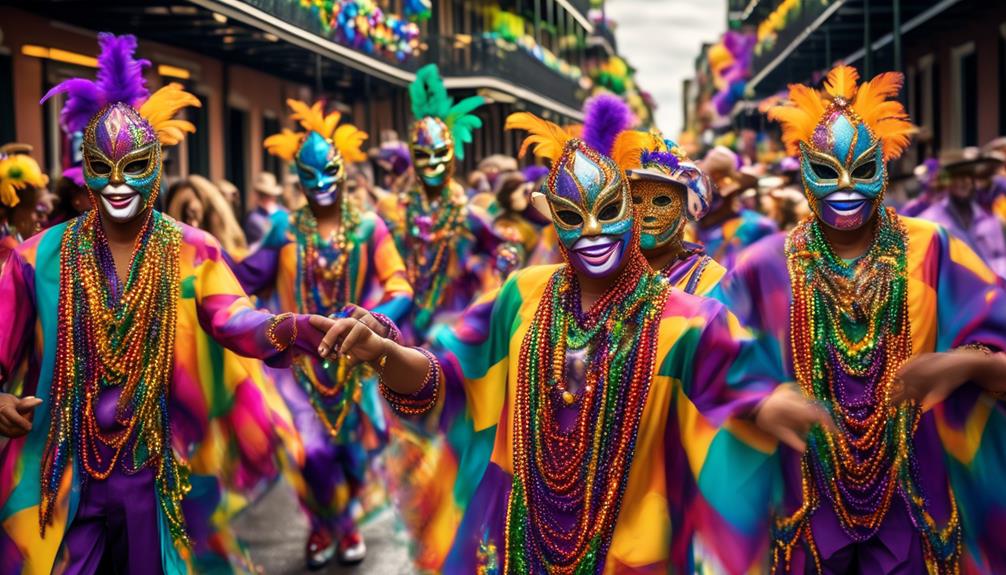
Tourists flock to our city during Mardi Gras, eager to experience the vibrant festivities and immerse themselves in the rich cultural tapestry of our community. As locals, we often observe tourists with a mix of amusement and empathy, understanding their desire to partake in the excitement. Here's what we've noticed about tourists during Mardi Gras:
- Tourist Attractions: Many tourists are drawn to the popular tourist spots, but we encourage them to explore beyond the well-trodden paths and discover the hidden gems that locals cherish.
- Local Perspective: Some tourists come with preconceived notions about Mardi Gras, often based on misconceptions. Engaging with locals can provide a deeper understanding of the cultural significance of the event and its traditions.
- Mardi Gras Misconceptions: It's common for tourists to have certain misconceptions about Mardi Gras. Engaging with locals can dispel these myths and provide a more authentic experience.
- Cultural Significance: By interacting with locals, tourists can gain a deeper appreciation for the historical and cultural significance of Mardi Gras, going beyond the surface-level revelry to understand its roots and traditions.
As locals, we welcome tourists with open arms, eager to share our love for Mardi Gras and our city's vibrant culture.
Families
Families play a significant role in the Mardi Gras celebrations, as the festivities offer a wide range of family-friendly activities. From parades to mask-making workshops, there are numerous opportunities for families to bond and create lasting memories together.
The multigenerational traditions surrounding Mardi Gras make it a special time for families to come together and participate in the vibrant cultural celebration.
Family-Friendly Activities
During Mardi Gras, we explore various family-friendly activities that offer entertainment for people of all ages.
- Kid-Friendly Parades: The parades during Mardi Gras aren't just for adults. Many of them are specifically designed to be enjoyable for children, with colorful floats, lively music, and plenty of throws that kids love to catch.
- Family-Friendly Costume Parties: Mardi Gras is a time for dressing up, and there are numerous family-friendly costume parties where both kids and adults can show off their creative outfits and enjoy the festive atmosphere.
- Interactive Workshops: Many Mardi Gras celebrations include interactive workshops where families can learn about traditional crafts, mask-making, and other hands-on activities.
- Carnival Rides and Games: Families can enjoy a variety of carnival rides and games, adding an extra element of fun to the Mardi Gras experience.
Multigenerational Traditions
One can observe how multigenerational traditions play a significant role in shaping the familial experience of Mardi Gras, fostering a sense of continuity and shared heritage.
Generational bonding is evident in the way families come together to partake in traditional rituals, passing down stories and customs from one generation to the next. The older members of the family impart their wisdom and experiences, while the younger ones bring energy and enthusiasm to the festivities.
This interplay creates a unique and enriching experience, strengthening family ties and preserving cultural practices.
As we gather to celebrate Mardi Gras, the blending of old and new traditions emphasizes the importance of maintaining our cultural identity while embracing the evolving dynamics within our families.
This multigenerational exchange ensures that the spirit of Mardi Gras lives on, transcending time and connecting us through shared experiences.
Partygoers

As the music blares and the colorful floats roll by, revelers in vibrant costumes and masks flood the streets, immersing themselves in the festive atmosphere of Mardi Gras.
- Creative Costumes: Every corner boasts a spectacle of inventive and elaborate costumes, showcasing the artistic expression and ingenuity of the partygoers.
- Parade Spectating: Crowds line the streets, eagerly anticipating the parades, with cheers erupting as each float passes by, creating an electric energy that's infectious.
- Nightlife Revelry: As the sun sets, the city transforms into a pulsating hub of nightlife, with bars and clubs overflowing with exuberant celebrants, adding a layer of excitement to the already vibrant city.
- Cultural Immersion: Amidst the revelry, there's a palpable sense of cultural immersion, where locals and visitors alike come together to revel in the traditions and spirit of Mardi Gras, creating a shared experience that transcends boundaries.
The partygoers, with their fervor and enthusiasm, contribute to the kaleidoscope of energy that defines Mardi Gras. It's a celebration that brings out the most exuberant and vivacious sides of people, uniting them in a shared revelry that's both invigorating and intoxicating.
Culture Enthusiasts
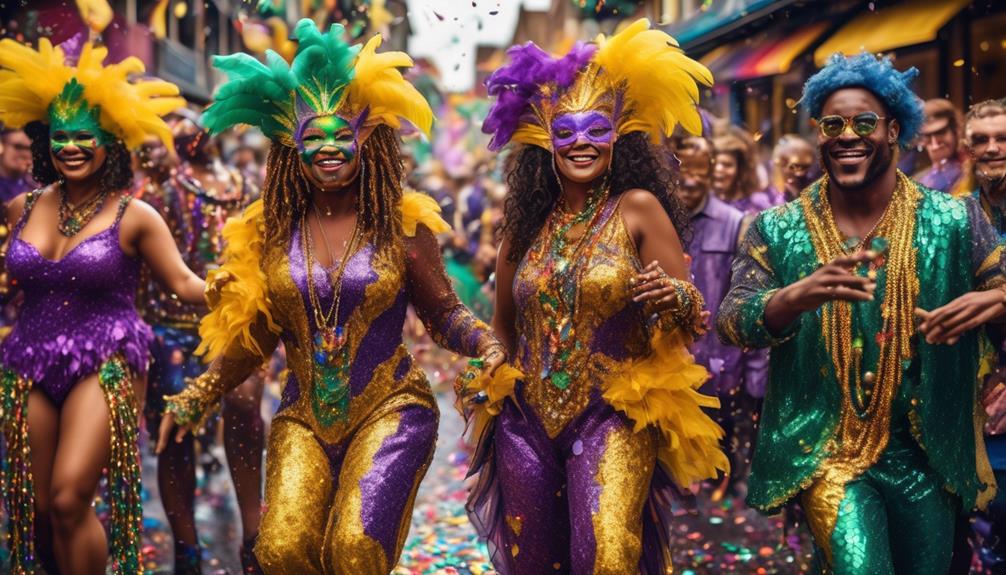
The vibrant costumes and lively atmosphere at Mardi Gras attract a diverse array of culture enthusiasts who eagerly engage in the rich traditions and heritage on display. Costume creativity is a hallmark of these culture enthusiasts, as they meticulously prepare intricate and flamboyant outfits that pay homage to the festival's historical and cultural significance. The parade spectating experience is a focal point for culture enthusiasts, who relish in the visual splendor of the floats, the rhythmic beats of the marching bands, and the exuberant energy of the performers.
As culture enthusiasts, we immerse ourselves in the vibrant tapestry of Mardi Gras, appreciating the fusion of various cultural elements that make this celebration so unique. We eagerly seek out the historical and cultural significance behind the elaborate costumes and meticulously crafted floats, and we engage in meaningful discussions with fellow enthusiasts to deepen our understanding of the traditions on display.
For us, Mardi Gras isn't merely a festival but a living, breathing showcase of cultural heritage that we cherish and celebrate with fervent passion.
Foodies
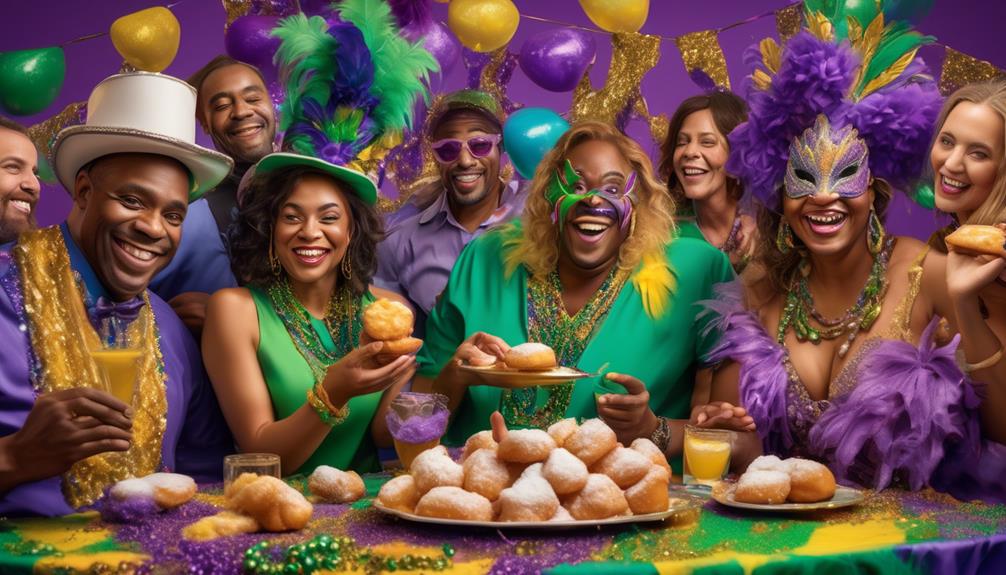
Amidst the colorful revelry and lively music of Mardi Gras, foodies are drawn to the tantalizing array of culinary delights that grace the festival grounds. The aroma of Cajun spices and the sizzle of seafood dishes create an irresistible allure for those who live to eat. Here's why foodies flock to Mardi Gras:
- Foodie Hotspots: From the bustling French Quarter to the vibrant streets of the Marigny, foodies seek out the hottest spots for indulging in the best Creole and Cajun cuisine.
- Culinary Traditions: Foodies are captivated by the rich culinary traditions that permeate the Mardi Gras experience. They eagerly embrace the centuries-old practices of gumbo, jambalaya, and King Cake, savoring each bite as a celebration of history and culture.
- Local Flavors: Foodies are on a mission to explore the diverse flavors of New Orleans. They eagerly sample everything from beignets and po'boys to oysters and étouffée, relishing the unique blend of influences that define New Orleans cuisine.
- Innovative Fusion: Foodies revel in the innovative fusion of flavors at Mardi Gras, where traditional recipes are reimagined and elevated to new heights, offering a fresh perspective on classic dishes.
For foodies, Mardi Gras is a feast for the senses, where every bite tells a story of tradition, innovation, and community.
Music Lovers
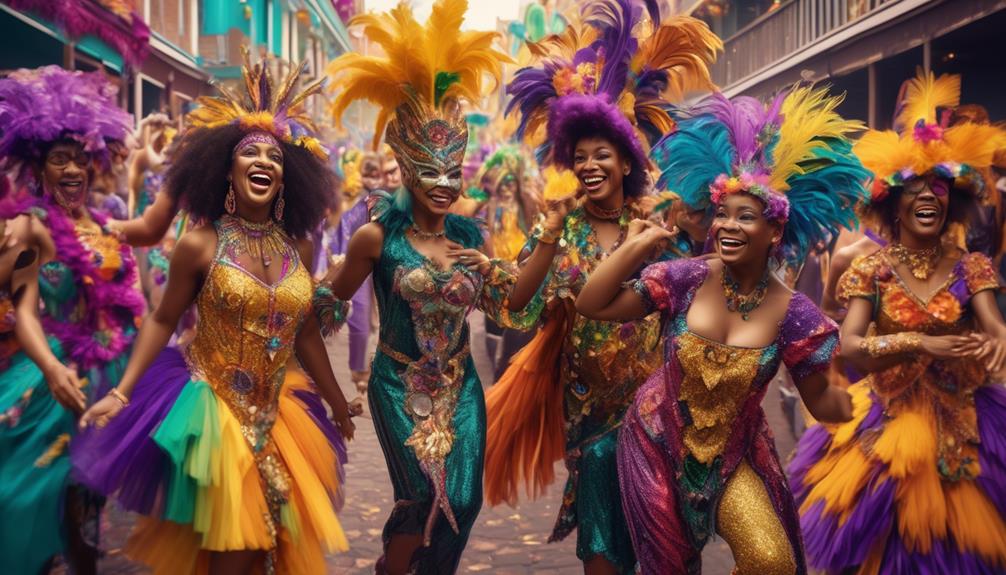
We've noticed that Mardi Gras attracts a diverse crowd of music lovers, from jazz enthusiasts to partygoers who relish the lively beats and infectious rhythms.
These individuals are drawn to the vibrant sounds that permeate the air, embodying the spirit of celebration and unity.
For many, Mardi Gras is an opportunity to immerse themselves in the rich musical heritage of New Orleans, making it a must-attend event for culture seekers and music aficionados alike.
Jazz Enthusiasts
Among the diverse array of individuals who partake in Mardi Gras festivities, jazz enthusiasts stand out as passionate music lovers who embrace the vibrant sounds and rhythms that define this cultural celebration.
Jazz enthusiasts often immerse themselves in local traditions and music appreciation, seeking out jazz festivals and live performances to experience the rich cultural heritage that Mardi Gras embodies. They understand the significance of jazz in shaping the identity of this festival and actively support local musicians who keep this tradition alive.
Jazz enthusiasts are known for their keen interest in the history and evolution of jazz, and they eagerly engage in discussions about the genre's influence on Mardi Gras and its enduring impact on the community.
Their love for jazz isn't just a musical preference; it's a deep connection to the spirit and soul of Mardi Gras.
Partygoers
As jazz enthusiasts immerse themselves in the vibrant sounds of Mardi Gras, partygoers who are music lovers can be seen embracing the lively atmosphere and diverse musical performances throughout the festivities. The nightlife scene during Mardi Gras becomes a haven for those seeking a fusion of celebration and music.
As the revelry culture takes hold, we find ourselves surrounded by a mix of traditional jazz, blues, and contemporary tunes, creating an electrifying ambiance that captivates the soul. The energy is contagious, drawing us into a world where live music intertwines seamlessly with the joyous spirit of the celebrations.
It's enthralling to witness how the music becomes a unifying force, bringing together people from all walks of life, each finding their rhythm amidst the pulsating beats and infectious melodies.
Culture Seekers
Culture seekers who are music lovers often find themselves drawn to the eclectic and vibrant atmosphere of Mardi Gras, where they can immerse themselves in a diverse range of musical performances and experience the contagious energy of the celebrations.
- Cultural Immersion: The variety of musical genres, from jazz and blues to zydeco and funk, provides an immersive experience into the rich cultural tapestry of New Orleans.
- Exploring Traditions: Witnessing traditional Mardi Gras Indian tribes parading through the streets and engaging in musical showdowns offers a unique opportunity to explore the deeply rooted traditions of the festival.
- Local Talent Showcase: Discovering emerging local bands and solo artists performing at venues throughout the city allows for an intimate glimpse into the vibrant music scene of New Orleans.
- Fusion of Sounds: The fusion of different musical influences during Mardi Gras reflects the city's diverse cultural heritage and creates a captivating auditory experience for music enthusiasts.
History Buffs
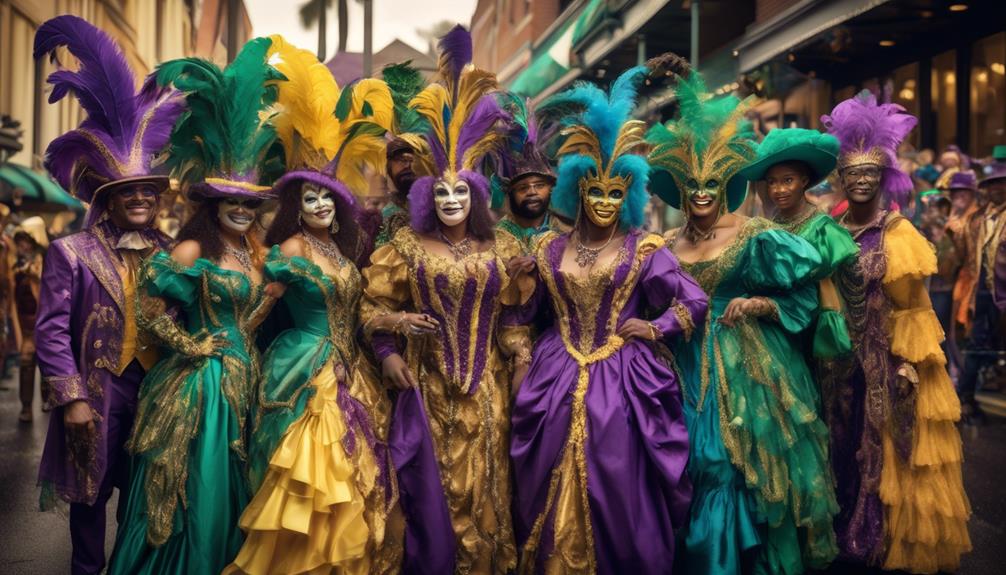
Many history buffs are drawn to Mardi Gras for its rich cultural significance and centuries-old traditions. The historical significance of Mardi Gras, especially in cities like New Orleans, offers a deep dive into the cultural heritage and traditional celebrations that have evolved over time. For history enthusiasts, Mardi Gras provides a fascinating exploration of how different cultures and historical events have shaped this iconic festival.
The intricate tapestry of Mardi Gras traditions, from the elaborate costumes to the grand parades, offers a glimpse into the past, showcasing the influences of various historical periods and the evolution of societal customs. The fusion of French, Spanish, African, and Caribbean influences in Mardi Gras traditions presents a captivating study of cultural exchange and adaptation over time.
Moreover, history buffs are often intrigued by the symbolism and rituals embedded in Mardi Gras, as they offer a window into the beliefs and values of the communities that have upheld these customs for generations. The historical depth and complexity of Mardi Gras make it an alluring subject for those with a passion for unraveling the intricate layers of our past.
Artists

The intricate tapestry of Mardi Gras traditions, with their vibrant colors and expressive forms, captivates artists and beckons them to explore the festival's visual richness and cultural symbolism.
Creative Expression: Mardi Gras provides a platform for artists to unleash their creativity through various mediums such as painting, sculpture, and street art, allowing them to infuse the celebration with their unique artistic visions.
Community Engagement: Artists play a pivotal role in fostering a sense of community during Mardi Gras, organizing workshops, collaborative art projects, and interactive installations that bring people together through the shared experience of artistic expression.
Artistic Traditions: Mardi Gras is steeped in artistic traditions that have been passed down through generations, inspiring artists to both honor these customs and reinvent them in contemporary contexts.
Costume Design: The elaborate and flamboyant costumes of Mardi Gras are a canvas for artistic expression, with designers and creators pushing the boundaries of imagination to craft stunning, one-of-a-kind ensembles that showcase their artistic prowess.
As artists, we find Mardi Gras to be a vibrant tapestry of visual stimulation, a celebration that not only embraces our creative spirit but also fosters a sense of unity and belonging within the community. The festival's rich artistic traditions and the opportunity for innovative costume design make it an irresistible canvas for our artistic endeavors.
Frequently Asked Questions
How Did Mardi Gras Celebrations Evolve Over Time?
Over time, Mardi Gras celebrations have evolved in fascinating ways, influenced by cultural shifts.
The evolution of Mardi Gras is a testament to the rich tapestry of traditions and influences that have shaped this vibrant celebration.
From its roots in European pre-Lenten traditions to the fusion of diverse cultural elements in New Orleans, Mardi Gras has become a dynamic expression of community, creativity, and revelry.
What Are Some Traditional Mardi Gras Costumes and Their Significance?
Traditional costumes worn during Mardi Gras hold deep cultural significance. They've evolved over time, reflecting historical and societal changes. These costumes aren't just for show; they've a significant economic and community impact, fueling the costume industry and bringing communities together.
The symbolism behind these costumes often ties back to historical events and traditions, adding layers of meaning to the famous parades and lesser-known celebrations.
What Are Some Lesser-Known Mardi Gras Traditions and Customs?
Well, Mardi Gras food is like a colorful, eclectic tapestry woven from diverse culinary traditions. It's a feast for the senses, with unique rituals like the King Cake tradition and the Courir de Mardi Gras, where revelers ride on horseback in colorful costumes.
These lesser-known customs add depth to the celebration, reflecting the rich cultural tapestry of Mardi Gras. The food and rituals bring an intimate, vibrant energy to the festivities, making it a truly unique experience.
How Does Mardi Gras Impact the Local Economy and Community?
Mardi Gras has a significant economic impact on the local community. The festival attracts tourists who spend money on accommodations, food, and souvenirs, boosting the local economy.
Additionally, community involvement in Mardi Gras preparations and activities creates a sense of unity and pride. Volunteers, local businesses, and residents all contribute to the success of the event, fostering a strong bond within the community.
The economic and communal benefits of Mardi Gras are truly remarkable.
What Are Some Famous Mardi Gras Parades and Their History?
Mardi Gras parades are an explosion of color and rhythm, embodying the spirit of celebration. Iconic floats glide through the streets, showcasing intricate designs and vibrant themes.
The air is filled with the infectious energy of Mardi Gras music, and street performers captivate the crowd with their talent.
These parades have a rich history, each one adding to the tapestry of Mardi Gras tradition. It's a sight that brings people from all walks of life together to revel in the joy of the festivities.
Conclusion
So, in conclusion, Mardi Gras is a celebration for everyone! Whether you're a local who loves to embrace your culture, a tourist looking for a good time, a family enjoying the parades, or a partygoer seeking some fun, there's something for everyone.
And let's not forget the history buffs, music lovers, and foodies who can indulge in the rich traditions and delicious cuisine. Mardi Gras truly brings people of all kinds together in a vibrant and festive atmosphere.
- About the Author
- Latest Posts
Introducing Ron, the home decor aficionado at ByRetreat, whose passion for creating beautiful and inviting spaces is at the heart of his work. With his deep knowledge of home decor and his innate sense of style, Ron brings a wealth of expertise and a keen eye for detail to the ByRetreat team.
Ron’s love for home decor goes beyond aesthetics; he understands that our surroundings play a significant role in our overall well-being and productivity. With this in mind, Ron is dedicated to transforming remote workspaces into havens of comfort, functionality, and beauty.
Mardi Gras Decoration
What Do the Colors of the King Cake Mean?
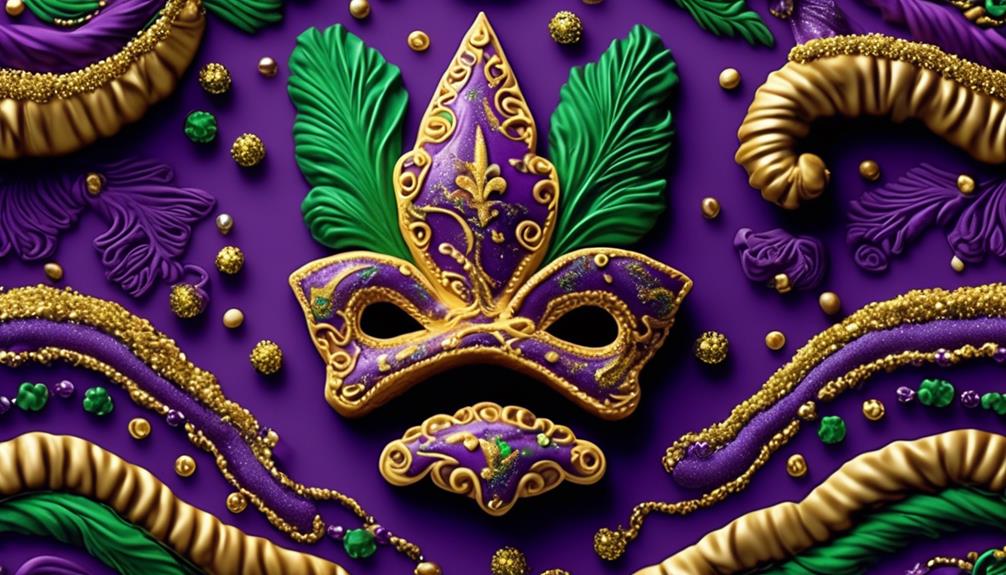
When talking about the King Cake, the colors have a special meaning that goes beyond just being decorative. The bright shades of purple, green, and gold are filled with tradition and symbolism, each representing a long history and significant cultural importance.
But what exactly do these colors represent, and how do they tie into the festive traditions of Mardi Gras and the King Cake?
Join us as we uncover the hidden meanings behind the colors of the King Cake and explore the fascinating stories that have shaped this beloved confection into a symbol of celebration and community.
Key Takeaways
- The colors of the King Cake hold deep symbolic meanings in Mardi Gras tradition.
- Purple represents justice and dignity, reminding us of the importance of fairness and equality.
- Green symbolizes faith, hope, and renewal, embodying the vitality of Mardi Gras festivities.
- Gold signifies prosperity, wealth, and regal splendor, adding an element of grandeur to the cake.
History of King Cake
The history of the King Cake dates back to the Middle Ages in France, where it was originally associated with the Epiphany celebrations. This delectable pastry has been an integral part of cake traditions for centuries, symbolizing the arrival of the three wise men to see the infant Jesus.
Over time, the King Cake became associated with Mardi Gras, also known as Fat Tuesday, marking the last day of indulgence before the solemnity of Lent. The cake's circular shape represents the circular route that the wise men took to confuse King Herod and protect the infant Jesus.
Inside the cake, a small trinket, often a tiny figurine representing the baby Jesus, is hidden. The person who finds the trinket is bestowed with good luck and is responsible for hosting the next King Cake party. This tradition has been upheld throughout history, fostering a sense of community and celebration among friends and family.
Understanding the historical significance of the King Cake adds depth and richness to the vibrant Mardi Gras traditions that continue to thrive today.
Origins of Mardi Gras

We will now explore the origins of Mardi Gras and its significance in the context of the King Cake. Understanding the historical roots of this celebration will shed light on the traditions and customs associated with the vibrant colors of the cake.
Origins of Celebration
Emerging from the traditions of ancient Roman and pagan celebrations, Mardi Gras has evolved into a vibrant and exuberant festival known for its colorful parades, lively music, and elaborate masks.
The origins of this celebration can be traced back to medieval Europe, where it was linked to the Christian liturgical calendar and marked the period before the solemn season of Lent.
Over time, Mardi Gras became intertwined with various festive traditions brought to the United States by French and Spanish settlers, eventually finding its epicenter in New Orleans.
The city's diverse cultural influences, including those from African and Caribbean traditions, further enriched the festival, contributing to the unique blend of music, dance, and culinary delights that characterize modern Mardi Gras celebrations.
This amalgamation of historical influences has resulted in the dynamic and spirited event that continues to captivate revelers worldwide.
Symbolism in Colors
Rooted in the historical tapestry of Mardi Gras, the symbolism of colors holds significance that reflects the rich origins of this vibrant celebration. The colors of the King Cake, purple, green, and gold, have deep symbolic meanings that are integral to the tradition of Mardi Gras. Each color represents a unique aspect of the cultural significance and history of this festival.
| Color | Representation |
|---|---|
| Purple | Represents justice, symbolizing the passion and strength of the community. |
| Green | Symbolizes faith, embodying the hope and vitality that underpins the Mardi Gras festivities. |
| Gold | Signifies power, evoking the spirit of achievement and resilience in the face of adversity. |
These colors are not just decorative; they are a testament to the enduring traditions and values that have shaped Mardi Gras over the centuries.
Symbolism of Purple
Purple, one of the traditional colors of Mardi Gras, holds significant symbolism in the context of the festival. Historically, purple has been associated with royalty and justice, reflecting the regal and noble aspects of the celebration.
Additionally, it also carries a connection to Lent and penitence, reminding us of the religious observance intertwined with the festivities.
Royalty and Justice
In the historical context of Mardi Gras and the tradition of King Cake, the color purple symbolizes royalty and justice, reflecting the significance of these themes in the celebration of this festive occasion.
The royal traditions of Mardi Gras are deeply intertwined with the symbolism of the King Cake, where the color purple represents the dignity and sovereignty associated with kings and queens.
Additionally, the color purple also conveys the concept of justice, reminding us of the importance of fairness and equality in society.
This symbolism harkens back to the origins of Mardi Gras as a period of revelry before the solemn season of Lent, where the themes of royalty and justice were particularly relevant.
The use of purple in the King Cake thus serves as a meaningful reminder of these enduring values during the festive celebrations.
Lent and Penitence
As we consider the symbolism of purple in the context of Lent and penitence, it becomes evident that the color's representation of royalty and justice in the celebration of Mardi Gras holds a profound connection to the solemn observance of Lent.
Purple, historically associated with royalty, reflects the solemn and introspective nature of the Lenten season. In the traditional lenten traditions, purple is a symbol of penitence, humility, and spiritual significance. It serves as a reminder of the sacrifices and self-reflection that are central to the Lenten period.
The use of purple in religious ceremonies during Lent underscores the spiritual significance of this color, evoking a sense of reverence and introspection. It symbolizes a time of spiritual preparation, self-examination, and repentance, aligning with the deeper spiritual themes of the Lenten season.
Meaning of Green
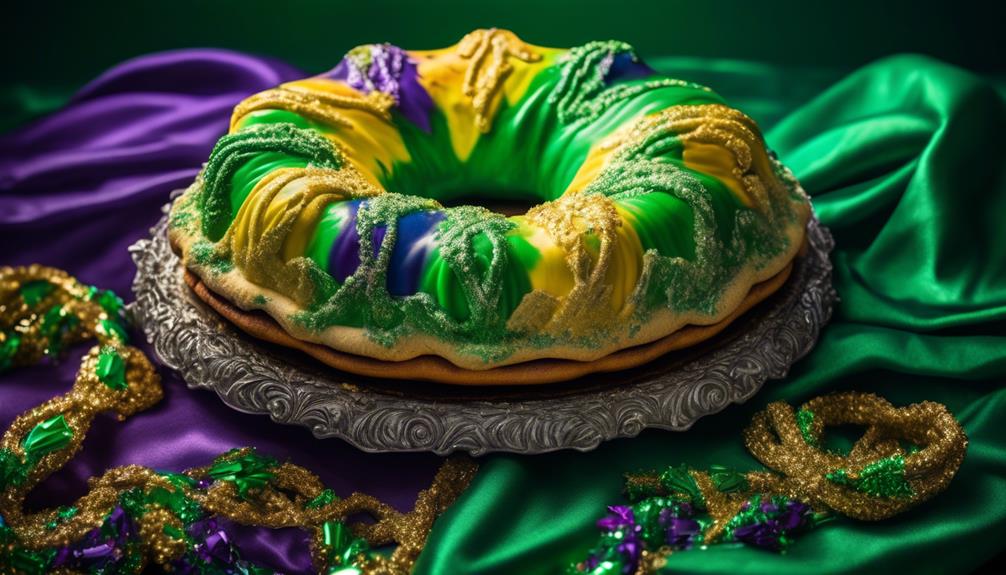
Green symbolizes growth, renewal, and prosperity, embodying the hope and vitality associated with the celebration of King Cake. The green color in the King Cake holds significant traditional associations.
In the context of the Christian faith, green represents the liturgical season of Epiphany, which occurs after the twelve days of Christmas and continues until the beginning of Lent. Epiphany is a time of manifestation and revelation, celebrating the visit of the Magi to the infant Jesus and the revelation of Christ to the Gentiles. Green also signifies the anticipation of spring, a period of new life and growth.
This symbolism aligns with the themes of abundance and new beginnings that are central to the spirit of Mardi Gras and the King Cake tradition. Additionally, green is often linked to the notion of prosperity and good fortune. It reflects the promise of a fruitful year ahead and the optimism for a bountiful harvest.
Thus, the presence of green in the King Cake serves as a reminder of the interconnectedness of spiritual and earthly blessings, emphasizing the joyous and hopeful nature of the occasion.
Significance of Gold

The significance of gold in the context of the King Cake is rich with historical and cultural symbolism. Gold has long been associated with prosperity and wealth, making it a fitting color for a cake that's traditionally enjoyed during celebrations and feasts.
Additionally, the connection to kingship adds a layer of regal symbolism to the use of gold in the King Cake tradition.
Symbolism of Prosperity
Gold, with its shimmering allure and timeless association with wealth and success, holds a prominent place in the symbolism of prosperity within the tradition of King Cake.
In various cultural traditions, the color gold has been revered for its representation of prosperity and good fortune. Within the context of the King Cake, the significance of gold goes beyond its visual appeal. It embodies the aspirations for a prosperous and successful future.
By incorporating the color gold into the decoration of the King Cake, the tradition imparts a sense of optimism and abundance to the celebration. This symbolism aligns with the historical significance of the cake as a token of good luck and prosperity for the coming year.
Thus, the inclusion of gold in the King Cake not only adds visual splendor but also infuses the tradition with deep-rooted cultural meanings.
Representation of Wealth
In exploring the tradition of King Cake, the symbolic significance of gold extends beyond its visual appeal to embody aspirations for prosperity and success.
The presence of gold in the colorful confections of King Cake symbolizes not just material wealth, but also the richness of spirit and the pursuit of excellence.
Throughout history, gold has been associated with power, luxury, and achievement, making it a fitting representation of wealth in these symbolic desserts.
The use of gold in King Cake reflects a desire for abundance and fulfillment, both in a tangible and spiritual sense.
This tradition not only adds a touch of opulence to the cake but also serves as a reminder of the values and aspirations embedded within the vibrant culture that celebrates this symbolic dessert.
Connection to Kingship
Embodying regal splendor and authority, the shimmering hue of gold in the King Cake tradition is steeped in historical and cultural significance, reflecting the connection to kingship through its symbolic representation of wealth and power.
The significance of gold in the King Cake holds a deep-rooted connection to regal traditions and royal connections, symbolizing the following:
- Wealth and Prosperity: Gold, as a color associated with opulence and prosperity, symbolizes the wealth and abundance traditionally associated with kings and royalty.
- *Historical Context*: In ancient societies, the possession of gold was a sign of power and authority, often reserved for the ruling class.
- *Cultural Symbolism*: The use of gold in the King Cake pays homage to the historical and cultural associations of wealth and prosperity with royalty, underscoring the regal heritage of this tradition.
The golden adornments in the King Cake not only add an element of grandeur but also serve as a reminder of the enduring link between this festive delicacy and the opulence associated with kingship.
Religious Connections

The colors of the King Cake hold significant religious connections, reflecting the rich historical and cultural influences on this traditional dessert.
The purple, green, and gold hues are deeply rooted in religious symbolism and traditional beliefs. In the context of Christianity, purple symbolizes justice, green represents faith, and gold signifies power.
These colors are tied to the season of Epiphany, which commemorates the visit of the Magi to the infant Jesus, and the revelation of Christ to the Gentiles.
Historically, the colors of the King Cake have been associated with the journey of the Magi, with purple representing royalty, green symbolizing the renewal of life, and gold signifying the gifts presented to Jesus.
This intertwining of religious symbolism and traditional beliefs has endured for centuries, shaping the significance of the King Cake within the Christian faith.
Understanding the religious connections of the King Cake's colors adds a layer of depth to the enjoyment of this beloved dessert, providing insight into the cultural and spiritual significance that enriches its consumption.
Cultural Representations
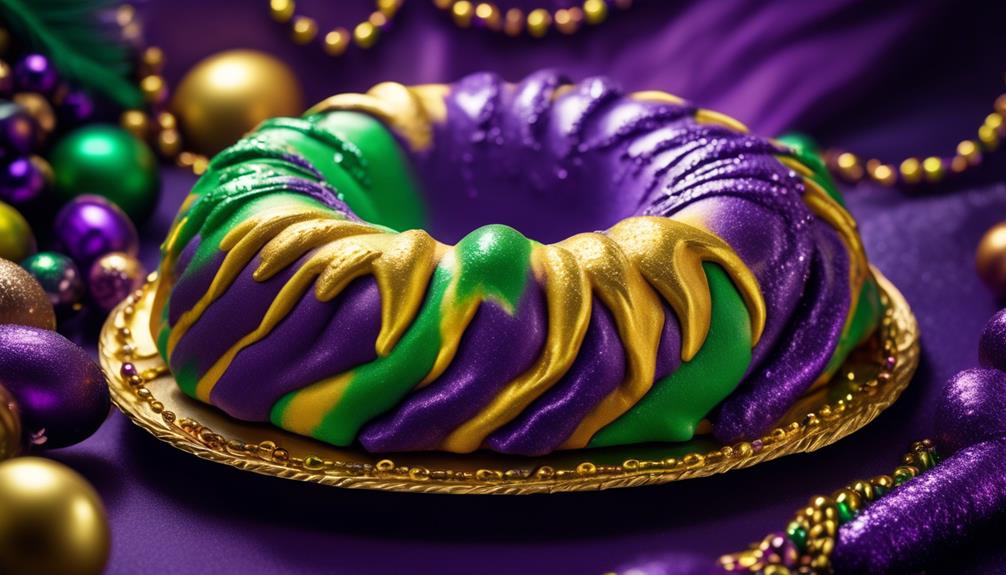
Reflecting the diverse cultural influences on the King Cake, its colors serve as visual markers of historical traditions and communal celebrations. Throughout history, cultural traditions have played a significant role in shaping the symbolic meaning of the King Cake's vibrant colors. The festive colors of the King Cake, typically purple, green, and gold, are deeply rooted in cultural significance:
- Cultural Traditions
- The purple hue, representing justice, is a nod to the Christian liturgical season of Lent. This color also pays homage to the European roots of the cake, where purple symbolizes royalty and penance.
- The green color, symbolizing faith, is a reflection of the cake's ties to the Christian Epiphany and the renewal of faith. It also represents the lush greenery of New Orleans, where the cake holds a prominent place in Mardi Gras celebrations.
These cultural representations not only add depth to the King Cake's symbolism but also showcase the rich historical tapestry of the communities that have embraced this beloved dessert. The festive colors of the King Cake serve as a visual reminder of the diverse cultural traditions and communal celebrations that have contributed to its enduring popularity.
King Cake Traditions
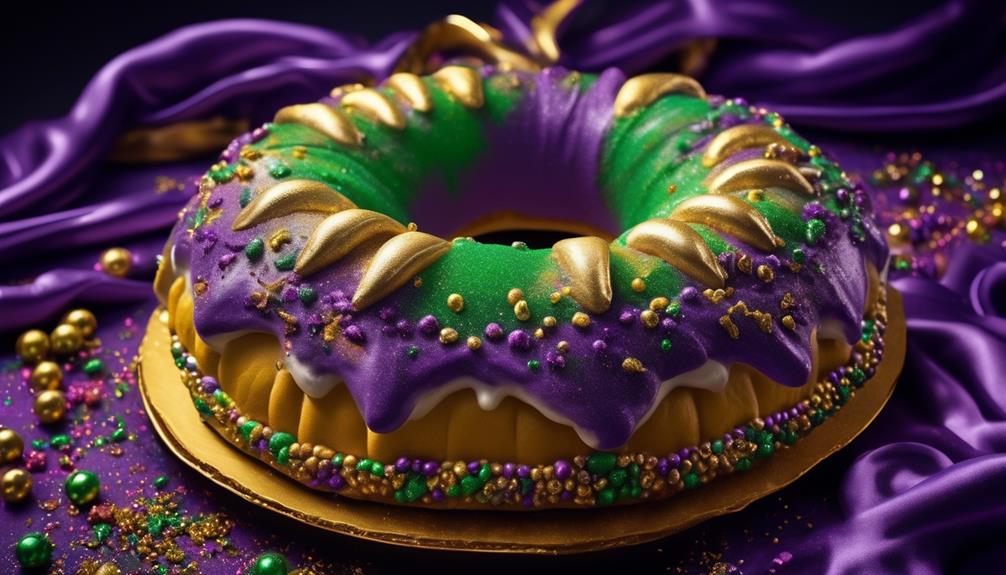
Rooted in centuries-old customs and festivities, King Cake traditions have evolved to encompass a rich tapestry of cultural practices and rituals. From the vibrant Mardi Gras celebrations in New Orleans to the joyful gatherings in France, the traditions surrounding King Cake vary widely, reflecting the diverse cultural influences that have shaped them over time. One of the most intriguing aspects of these traditions is the wide array of King cake flavors and decorations, each holding its own symbolic meaning and significance.
| Tradition | Description | Variations |
|---|---|---|
| King Cake Parties | Gatherings where friends and family come together to share the cake, often with a hidden trinket or figurine inside. | Some regions host elaborate masquerade balls, while others opt for casual potluck-style gatherings. |
| King Cake Decorations | The cake is adorned with colorful sugar in the hues of purple, green, and gold, symbolizing justice, faith, and power. | In some cultures, the decorations may include additional elements such as ribbons, beads, or even small crowns. |
| King Cake Flavors | Originally a simple brioche-like dough, today's King Cakes come in a variety of flavors, such as cinnamon, cream cheese, or fruit-filled. | Some regions have developed unique flavor combinations, tying the cake to local culinary traditions. |
These traditions and variations highlight the dynamic nature of King Cake customs and the ways in which they continue to evolve while preserving their cultural significance.
Colorful Mardi Gras Festivities
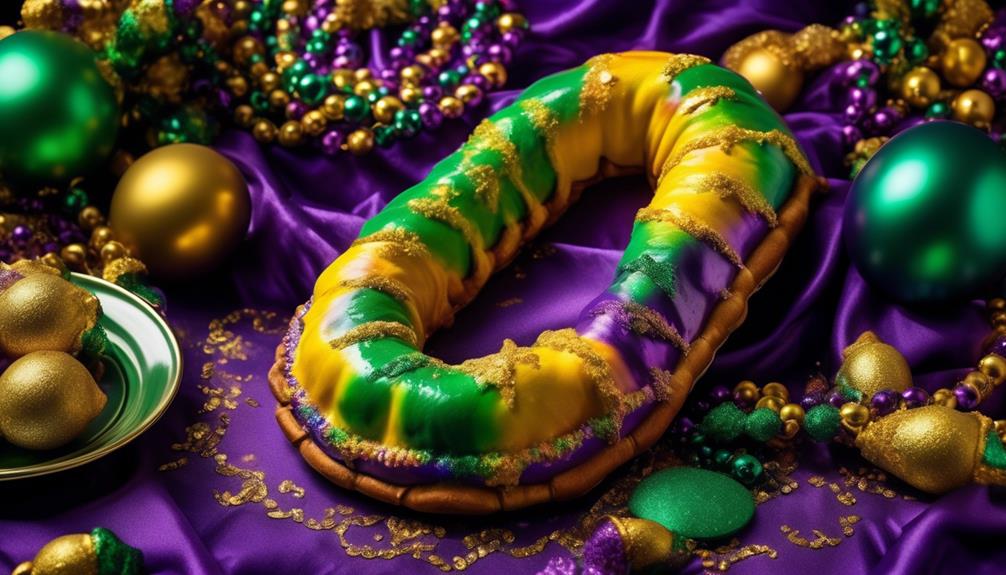
Amidst the vibrant and jubilant Mardi Gras festivities, the colors of purple, green, and gold take on a symbolic significance that traces back to the historical roots of this exuberant celebration. These hues aren't just mere decorations; they represent the essence of Mardi Gras and carry a rich cultural significance.
Festive decorations
The streets are adorned with colorful banners, ribbons, and masks, creating a kaleidoscope of vibrant hues that symbolize the joy and liveliness of the occasion. Buildings and floats are draped in these iconic colors, setting the stage for the revelry and adding to the infectious energy of the celebration.
Colorful confections
King cakes, the quintessential treat of Mardi Gras, are adorned with purple, green, and gold sugars, each color holding its own meaning. Purple represents justice, green symbolizes faith, and gold signifies power. These confections not only delight the taste buds but also serve as visual representations of the festival's core values, enriching the overall experience.
The amalgamation of these colorful elements creates an atmosphere that isn't only visually stunning but also deeply rooted in tradition, making Mardi Gras a truly enchanting and immersive celebration.
Modern Interpretations

In contemporary times, the traditional and symbolic colors of purple, green, and gold in Mardi Gras celebrations have evolved to encompass a broader spectrum of interpretations, reflecting the dynamic cultural landscape of modern society.
Modern interpretations of these colors go beyond their historical ties to justice, faith, and power. Purple, once associated with royalty, has taken on new meanings such as individuality and diversity. Green, traditionally symbolizing faith, now represents environmental consciousness and community. Gold, which historically denoted power, now signifies not only wealth but also prosperity and optimism for the future.
The modern interpretations of the colors of the King Cake speak to the cultural significance of Mardi Gras in contemporary society. They reflect the changing values and priorities of the present day, highlighting themes of inclusivity, sustainability, and hope.
As our understanding of the world evolves, so too does the symbolism we attach to these vibrant hues, making the King Cake not only a delicious treat but also a reflection of our ever-changing societal landscape.
King Cake in Contemporary Society
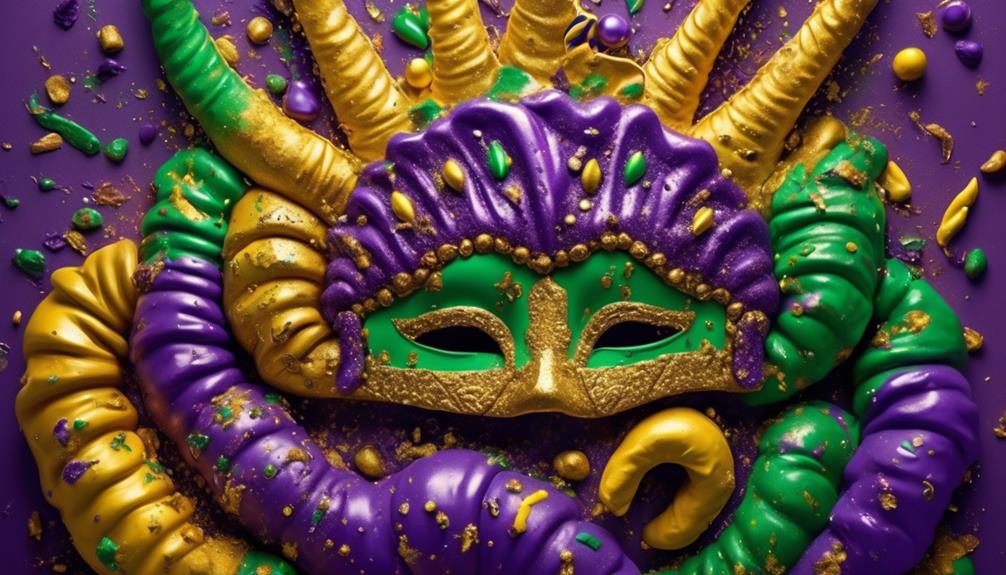
The significance of King Cake in contemporary society extends beyond its traditional roots, embodying the evolving cultural and social dynamics of our modern world.
As we delve into the contemporary traditions surrounding King Cake, we find that its decorations have evolved to reflect the diverse tapestry of our society.
- Inclusive Decorations
- King Cakes today often feature decorations that represent a wide range of cultural and religious symbols, embracing inclusivity and celebrating diversity. This reflects the contemporary societal value of honoring various traditions and backgrounds.
- Customization and Personalization
- In today's society, there's a growing trend of customizing and personalizing King Cakes to reflect individual preferences and beliefs. This trend mirrors the contemporary emphasis on personal expression and individuality, where people are encouraged to celebrate their unique identities.
The evolution of King Cake decorations and contemporary traditions reflects the ever-changing landscape of our society. As we celebrate with King Cake, we not only honor its historical significance but also pay homage to the inclusive and diverse nature of our modern world.
Frequently Asked Questions
Can the Colors of the King Cake Vary Depending on the Region or Cultural Traditions?
Absolutely, regional variations and cultural significance can influence the colors of the King Cake. In some areas, purple, green, and gold represent justice, faith, and power, while in others, they may symbolize different virtues or concepts.
These variations reflect the diverse cultural traditions and historical influences in different regions, adding depth and richness to the celebration of Mardi Gras.
Are There Any Specific Superstitions or Beliefs Associated With the Colors of the King Cake?
Superstitions and traditions around the colors of the king cake are fascinating. Different regions and cultures infuse their own unique meanings into the vibrant hues. The color variations hold deep seasonal representation and religious symbolism, making the cake not just a treat, but a reflection of rich cultural significance.
Understanding these superstitions and beliefs adds a layer of depth to the joyous tradition of sharing a king cake.
What Do the Colors of the King Cake Represent in Terms of the Mardi Gras Season as a Whole?
The colors of the King Cake, green, gold, and purple, symbolize Mardi Gras traditions and the spirit of the season. These hues represent faith, power, and justice, respectively. In the context of Mardi Gras symbolism, they embody the festive and celebratory mood of this time.
King Cakes aren't just traditional desserts; they're a significant part of the Mardi Gras culture, carrying rich historical and cultural meanings through their vibrant colors.
Do the Colors of the King Cake Have Any Significance in Other Cultural or Religious Celebrations?
The colors of the King Cake hold deep significance in various cultural and religious celebrations. Symbolizing justice, faith, and power, these hues are woven into cultural traditions and religious ceremonies, adding vibrancy and symbolism to the festivities.
From Mardi Gras to other global celebrations, the colors play a vital role, reflecting the values and beliefs of the communities that embrace them. Their significance extends far beyond mere decoration, enriching the tapestry of diverse traditions.
Are There Any Alternative Interpretations of the Colors of the King Cake in Contemporary Society?
When it comes to the colors of the king cake, there are various alternative interpretations and modern symbolism that have emerged in contemporary society.
These interpretations often reflect cultural variations and contemporary significance, adding new layers of meaning to the traditional symbolism.
As societal values and beliefs evolve, the colors of the king cake may take on different connotations, reflecting the dynamic nature of cultural traditions in today's world.
Conclusion
In conclusion, the colors of the king cake hold deep historical and symbolic significance. From the origins of Mardi Gras to the modern interpretations of the cake, the purple, green, and gold colors represent justice, faith, and power respectively.
It's fascinating to note that over 500,000 king cakes are consumed during the Mardi Gras season in New Orleans alone, making it a beloved tradition with a rich cultural heritage.
- About the Author
- Latest Posts
Introducing Ron, the home decor aficionado at ByRetreat, whose passion for creating beautiful and inviting spaces is at the heart of his work. With his deep knowledge of home decor and his innate sense of style, Ron brings a wealth of expertise and a keen eye for detail to the ByRetreat team.
Ron’s love for home decor goes beyond aesthetics; he understands that our surroundings play a significant role in our overall well-being and productivity. With this in mind, Ron is dedicated to transforming remote workspaces into havens of comfort, functionality, and beauty.
-

 Vetted3 weeks ago
Vetted3 weeks ago15 Best Contact Paper for Kitchen Cabinets to Elevate Your Home Decor
-

 Vetted1 week ago
Vetted1 week ago15 Best Poe Cameras for Home Security – Reviews & Buying Guide
-

 Vetted4 weeks ago
Vetted4 weeks ago15 Best Leather Restorer Products to Revive Your Furniture and Accessories
-

 Vetted3 weeks ago
Vetted3 weeks ago15 Best Drain Snakes to Unclog Your Pipes Like a Pro
-

 Beginners Guides12 hours ago
Beginners Guides12 hours agoI Inhaled Vinegar Fumes
-

 Vetted3 weeks ago
Vetted3 weeks ago14 Best Stationery Brands for Your Next Writing Adventure
-

 Beginners Guides2 weeks ago
Beginners Guides2 weeks agoSwinger Porch Light Color
-

 Mardi Gras Decoration3 weeks ago
Mardi Gras Decoration3 weeks agoWhy Does Hobby Lobby Not Do Mardi Gras?























